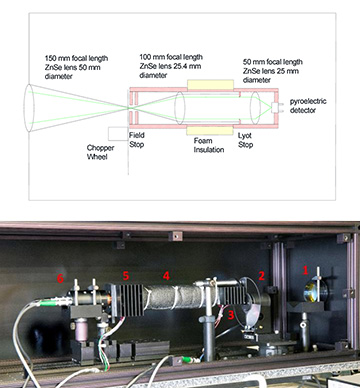Top: Schematic of the NIST ambient-radiation thermometer. Bottom: Lab photo of the device. 1, 50-mm ZnSe lens; 2, chopper wheel; 3, first lens in insulated cylinder, which converts radiation into parallel beam; 4, insulated cylinder, including Lyot stop; 5, second lens in insulated cylinder, which focuses radiation onto pyroelectric detector; 6, output electrical connection from detector. [Image: schematic from H.W. Yoon et al., Opt. Express, doi: 10.1364/OE.27.014246; photo from NIST] [Enlarge image]
Researchers at the U.S. National Institute of Standards (NIST), USA, report that they’ve designed significant improvements for research-grade thermal-infrared thermometers and sensors—particularly those targeted for use in field settings (Opt. Express, doi: 10.1364/OE.27.014246). One of the key improvements? Controlling the temperature of the instrument itself.
200-°C-wide sweet spot
Thermal-infrared thermometers, which have been around since the 1960s, work by detecting the infrared radiation emitted from objects at a distance. The most common radiation thermometers, and the focus of the new NIST work, operate in the mid-to-longwave-IR, 8-to-14-μm wavelength range. That range corresponds to object temperatures from –50 to 150 °C—a sweet spot for temperature measurements on planet Earth, according to OSA member Howard Yoon, a NIST engineer and the lead author on the new paper.
The 200 °C span of these instruments “covers nearly all naturally occurring temperatures on Earth,” he said in a NIST press release accompanying the research. “If you make a big impact in measuring objects in that range, it really matters.” Applications for such non-contact thermometers are legion, ranging from equipment diagnostics to clinical medicine to food assessments to measurements of sea-surface temperature and climate.
Temperature effects
Most thermal-infrared thermometers have a relatively simple design, essentially consisting of a lens to focus infrared radiation and a pyroelectric sensor to convert that focused heat energy to an electrical signal. And that very simplicity constitutes the devices’ Achilles heel.
For one thing, temperature variations along the extent of the thermometer can destabilize the instrument, leading to errors and reducing precision. And these simple designs are also prone to large “size of source” effects—errors due to diffraction, scattering and other optical effects that cause part of the radiation coming from outside of the instrument’s nominal field of view to reach the detector, gumming up the temperature reading.
Some of these stability problems, of course, can be compensated for in instruments in the laboratory, via frequent recalibrations and adjustments. But for work in the field, and for instrumental precisions within a few thousandths of a degree, an instrument that can remain stable for long periods is a must.
Lenses, stops and a chopper
To get to that kind of stability, the NIST team devised a 60-cm-long prototype that begins with a 50-mm, plano-convex zinc selenide lens, with a 150-mm focal length, to concentrate IR radiation into an aperture whose size is controlled by a field stop. Just in front of the field stop, a “chopper” wheel—covered with reflective aluminum tape to reduce its own emittance, and rotating at a 4-Hz rate—separates the IR radiation into pulses of a size digestible by pyroelectric detectors. Those pulses pass into a 30-cm-long insulated central chamber including additional ZeSe lenses and a wide-aperture Lyot stop. Finally, the pulse stream is focused onto a pyroelectric detector for the temperature measurement.
To control for the along-axis temperature variations that can bedevil accuracy, the NIST team installed thermometers, thermo-electric coolers and themistors along the device’s 30-cm-long central cylinder. Those controls are linked into a clever feedback loop that adjusts the device temperature continually, keeping things at a comfortable 23 °C at all points along the instrument. And the use of the Lyot stop, which blocks stray radiation, helps protect the instrument from size-of-source effects.
Into the field?
In tests of the instrument (after calibration using contact thermometers), Yoon and his team found that it could produce measurement resolutions at the sub-millikelvin level, without any need for cryogenic cooling, while measuring room-temperature objects. And they also established that it remained stable for weeks at a time—a clear plus for field applications.
Among those applications, Yoon particularly cites some related to weather and climate studies. “Imagine being able to take the NIST design out in the field as traveling radiation thermometers for accurately measuring variables such as land- and sea-surface temperatures,” he said in the NIST press release. “It could serve as a trustworthy method of calibrating satellite IR sensors and validating the huge weather science programs that are used to predict, for example, the paths and strengths of hurricanes.”

